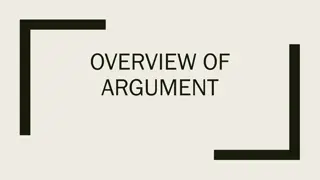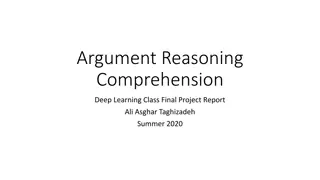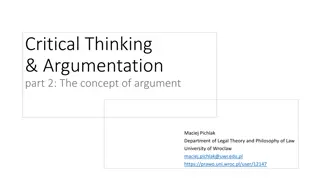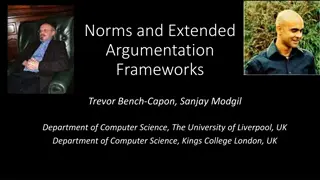Understanding Stasis Theory in Argumentation
Stasis theory in argumentation helps identify the point of disagreement by categorizing issues into facts, definition, quality, and policy. It assists in framing debates and responses to opponents by asking questions about the nature, seriousness, and plan of action regarding the problem or issue at hand.
Download Presentation

Please find below an Image/Link to download the presentation.
The content on the website is provided AS IS for your information and personal use only. It may not be sold, licensed, or shared on other websites without obtaining consent from the author. Download presentation by click this link. If you encounter any issues during the download, it is possible that the publisher has removed the file from their server.
E N D
Presentation Transcript
The term stasis ultimately derives from the ancient Greek word for stand. It can refer to a person who takes a stand on an issue. In the case of an argument and this is essential for our purposes stasis denotes the point at which opposing sides come together, the point at which they rest or stand in agreement on what is at issue (Crowley & Hawhee, 2012, p. 58). What is Stasis?
A man believes the late Freddy Mercury, who was the lead singer of Queen, is the greatest singer of the 20th century, yet may find his partner thinks otherwise: Man: Freddy Mercury is the best singer. Partner: Freddy Mercury is not the best singer. What is Stasis? As formulated here, their disagreement is in stasis. It centers around a clear, identifiable issue. Thus, stasis is sometimes defined as the point on which disputants agree to disagree (Crowley & Hawhee, 2012, p. 59).
In the absence of a clearly articulated issue, those involved in a disagreement risk talking past one another. For example, arguments over abortion often proceed the following manner: Why Stasis matters Anti-Abortion Activist: Abortion is murder. Abortion Rights Activist: Women have the right to bodily autonomy. These are two very different arguments; they do not, in fact, rest or stand in agreement on what is at issue (Crowley and Hawhee, 2007, p. 58).
Stasis theory can be used to analyze a disagreement as an outside or impartial observer. It can also be used to analyze a disagreement as an invested participant. That is, rhetors can employ stasis theory to help determine how to frame a debate and how to respond to opponents. Stasis Theory Stasis theory enables us to identify or establish the point(s) of disagreement in a dispute. It proceeds by employing a series of categories and questions known as the stases.
Stasis theory asks writers to investigate and try to determine: The facts (conjecture) The meaning or nature of the issue (definition) The seriousness of the issue (quality) The plan of action (policy). (Brizee, 2013) Stasis Theory
Is there a problem or issue? What changed to create the problem/issue? What happened to bring attention to the issue/problem? How did it begin and what are its causes? Stasis 1: The Facts/ Conjecture What are the facts surrounding the issue/problem? Can the issue/problem be changed? Ask critical questions of your own research and conclusions: Where was the data obtained and are these sources reliable? Why are the sources reliable? (Brizee, 2013)
What is the nature of the problem/issue? What exactly is the problem/issue? What kind of a problem/issue is it? To what larger class of things or events does it belong? Stasis 2: Definition What are its parts, and how are they related? It may also be useful to ask critical questions of your own research and conclusions: Who/what is influencing our definition of this problem/issue? How/why are these sources/beliefs influencing our definition? (Brizee, 2013)
Is it a good thing or a bad thing? How serious is the problem/issue? Whom might it affect (stakeholders)? What happens if we don't do anything? Stasis 3: Quality What are the costs of solving the problem/issue? It may also be useful to ask critical questions of your own research and conclusions: Who/what is influencing our determination of the seriousness of this problem/issue? How/why are these sources/beliefs influencing our determination? (Brizee, 2013)
Should action be taken? Who should be involved in helping to solve the problem/address the issue? What should be done about this problem? What needs to happen to solve this problem/address this issue? Stasis 4: Policy It may also be useful to ask critical questions of your own research and conclusions: Who/what is influencing our determination of what to do about this problem/issue? How/why are these sources/beliefs influencing our determination? (Brizee, 2013)
Achieving stasis means the parties involved in a dialogue about an issue has reached consensus on (or agreed upon) information and conclusions about one or more of the stases. In ancient Rome, if legal disputants could not agree with the presented information in one of the stases, the argument would stop (arrest) and plaintiffs would attempt to agree (achieve stasis or find common ground) within the disputed information it is also important to achieve stasis with the issue you are investigating. Put another way, if you are trying to solve the parking problem on your campus, it will not do anyone any good to suggest that students stop smoking. The solution has nothing to do with (does not achieve stasis with) the issue at hand. (Brizee, 2013) Achieving Stasis
When you use stasis theory to research a topic, you should ask yourself questions about the topic before you research. Then, you should answer those questions with research. Using Stasis Theory The following slides include examples of using stasis theory to investigate climate change.
Fact or Conjecture: Does it exist? Did it happen? Is the Earth s climate changing? If so, is it warming up, cooling down, or both? How and when did these changes start? What causes these changes? Are they caused by human activity? Do they happen naturally? Can they be slowed or stopped? Can they be hastened? (Edlund, n.d.) Stasis Theory: Climate Change Definition: How can the act or event be defined? Can these climate changes be defined as global warming or as something else? If so, how should we define global warming? How does global warming fit into the other aspects of climate change? How does it fit into the natural climate changes that led to ice ages in the past? What are the different parts of the process of climate change? (Edlund, n.d.)
Quality: What is the character of the act? Is climate change harmful? Is it right to try to stop it? Is economic prosperity better than energy conservation? Which is more important, the short-term health of the economy or the long-term stability of the climate? (Edlund, n.d.) Stasis Theory: Climate Change (continued) Policy: What should we do? Should we try to stop climate change? What will happen if we do nothing? Should we act to reduce emissions of greenhouse gasses? Should we try to conserve energy? Should we switch to nuclear power? Will any of these actions reduce global warming? Will these actions create other problems? (Edlund, n.d.)
Brizee, A. (2013). Stasis theory. Purdue Owl. Retrieved from https://owl.english.purdue.edu/owl/resource /736/1/ Crowley, S., & Hawhee, D. (2004). Ancient rhetorics for contemporary students (3rd. ed.). Boston: Pearson. References Edlund, J.R. (n.d.). Stasis Theory: Finding Common Ground And Asking Pertinent Questions. EWRC. Retrieved from https://www.cpp.edu/~class/english- foreignlanguages/docs/StasisTheoryIntro.pdf.

























